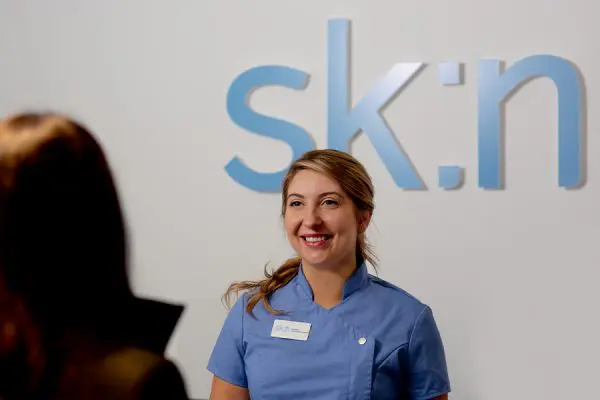Visit our state of the art facility in Portsmouth
Strict medical protocols for milia removal
Conveniently located near the old Portsmouth, one of over 50 clinics nationwide
Your Trusted Milia Removal Clinic in Portsmouth
Milia, also known as milk spots, are whitish or flesh-coloured bumps which appear on the surface of the skin, often around the eyes, nose and mouth. They can take months or even years to disappear by themselves, but at sk:n, we are able to safely and effectively remove milia altogether, leaving you with smooth, clear skin. Get your milia assessed by our team in Portsmouth to find out how we can help you.

The sk:n Portsmouth Medical Team
sk:n is home to more consultant dermatologists, doctors, plastic surgeons, nurses and therapists, than any other UK dermatology service provider.
The sk:n team in Portsmouth will ensure that your visit to the clinic is truly worthwhile: at sk:n we are passionate about helping you discover better skin.
So, whether you suffer from acne, unwanted facial hair, regret an old tattoo, or simply just want to freshen up your complexion – we have the most effective treatments on the market to help you achieve the results you long for.
Administered by a Qualified Doctor or Nurse
Procedure follows strict medical protocols
Performed in a safe and medical environment
Flexible appointments including evenings & weekends
Frequently asked questions
Can I remove milia myself?
Removing milia yourself is not recommended. To avoid infection, the treatment should be carried out in a safe clinical environment with sterile equipment. Trying to squeeze or pick at milia can cause the area to become inflamed, bruised or infected because they do not ‘pop’ in the same way as a pimple or whitehead.
How can I reduce the white spots under my eyes?
Ensure you have a good skincare routine can help reduce white spots under your eyes, which should involve good quality products, regular exfoliation and wearing high factor sun protection.
What are the different types of milia?
There are five main types of milia:
Neonatal milia: Neonatal milia or ‘milk spots’ are milia found on newborn babies. It is thought they are caused by sweat glands that haven’t fully developed yet and so become blocked easily.
Primary milia: Primary milia can appear on children or adults. They can disappear without treatment, but tend to last longer in adults and can often be permanent.
Secondary milia: These occur after injury or trauma to the skin. It is thought that this is due to damage caused to the sweat glands in the affected area, and can also be as a result of using certain types of creams.
Milia en plaque: This is a rarer type of milia that develops on a raised and inflamed patch of skin called a ‘plaque’.
Multiple eruptive milia: This is another rare type of milia that occurs when clusters appear over the course of a few weeks or months, and most commonly appear on the face, upper arms and the upper half of the torso.
Is milia removal safe?
Going to a regulated and qualified doctor is the best way to remove milia safely and effectively. All of our milia removal procedures are carried out in highly clinical, sterilised operating rooms by doctors with many years’ experience. They will follow strict medical protocols, which means you can be rest assured that the procedures are very safe.
Does milia removal hurt?
The removal of milia is virtually painless and there is no need to apply a numbing cream before the procedure.
Is there any downtime after milia removal?
There may be some slight redness to the treated area immediately following the milia removal procedure, however this subsides within a matter of hours and benefits of treatment can be noticed instantly.
Can skincare products cause or worsen white spots under the eyes?
If you do have Milia particularly around the eye area, it could be something to do with the skincare products you are using. The skin around the eye is much thinner than on the face, so when eye creams are thick and heavy they can block pored and trap dead skin cells. So make sure you invest in a good quality, light eye cream. Another cause could be sun damage or an allergic reaction to harsh facial products.
Can I wear makeup if I have milia?
You may feel like you want to cover up the white spots with makeup. However covering Milia with heavy makeup will stop your skin from shedding cells and may clog pores further, trapping keratin underneath your skin. Try to use breathable makeup, or instead of a foundation use light powder-based cover up.
Can milia be removed from around the eyes?
Removing milia from around the eyes yourself can be dangerous and should only be carried out by a doctor.
Does milia removal leave scars or marks?
Milia removal should not leave any scars or marks.
Is milia removal safe?
Going to a regulated and qualified doctor is the best way to remove milia safely and effectively. All of our milia removal procedures are carried out in highly clinical, sterilised operating rooms by doctors with many years’ experience. They will follow strict medical protocols, which means you can be rest assured that the procedures are very safe.
What natural/at-home remedies for milia are there?
Milia will usually go away naturally on their own, but in some cases they can take months or even years to disappear.
Regular exfoliation with a good exfoliating product and thorough removal of makeup before bed can help to prevent milia recurring, but will not remove existing milia. At sk:n we recommend to have milia removed in a safe, clinical environment.
What to do after milia removal?
After your milia removal your practitioner will provide you with full aftercare instructions. There may be some slight redness to the treated area immediately following the milia removal procedure, however this subsides within a matter of hours and benefits of treatment can be noticed instantly.
What to do before a milia removal treatment?
It’s likely you’ll be advised at your consultation to prepare your skin before your treatment by using a non-abrasive exfoliating cleanser and vitamin A product on a regular basis. These products will soften the skin that covers the milia, making it easier to remove and can also help prevent further milia developing.
Will milia fade without treatment?
This could be the case, with adults this could take a few months. However it is always best to get any skin conditions checked out by a trained professional. Definitely do not try any treatments at home or you could cause infection or scarring.
Where to go for milia removal?
It is important that you visit a private clinic such as sk:n where your milia can be removed professionally and safely.
Request a callback
One of our friendly sk:n advisors will call you to book your consultation.
- More than 450 consultants, doctors, nurses and medical practitioners
- Regulated by the Care Quality Commission, Health Inspectorate Wales and Health Improvement Scotland
- Partner of the NHS
- Rated excellent by our clients on Trustpilot
- Strict safety and care protocols
See all our clinics in Portsmouth
Portsmouth St Georges Square Opening Times
Monday
Closed
Tuesday
12:00 - 20:00
Wednesday
12:00 - 20:00
Thursday
12:00 - 20:00
Friday
10:00 - 18:00
Saturday
09:30 - 17:00
Sunday
Closed
Clinic Address
Unit 8 St. Georges Business Centre, St. Georges Square, Portsmouth, PO1 3EZ
Telephone
Finding us
Located at Unit 8, St George’s Square, close to the heart of the city, our clinic is easy to access. Free parking is available outside of the clinic, your registration number will need to be entered upon arrival. In case the clinic car park is busy, we recommend parking in Harbour Car Park which is a 4 minute walk away, with the station just 5 minutes walk.
From the M27 head towards the historic dockyard, past the tall ships and The Hard. The entrance with Gunwarf Quays will be on your right. Take the 2nd turning on the left into St Georges Square, which is a cobbled street area, then turn right past the Learning Links building.





